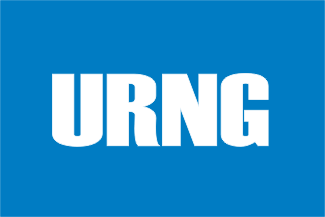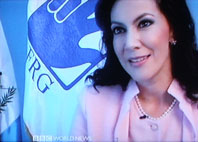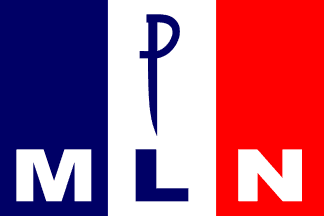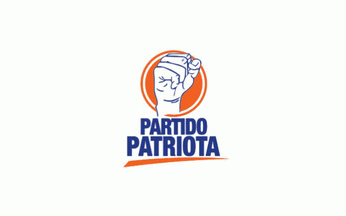
by Jaume Ollé, 8 May 2005

Last modified: 2014-05-29 by zoltán horváth
Keywords: guatemala | che |
Links: FOTW homepage |
search |
disclaimer and copyright |
write us |
mirrors
See also:
The flag of the Guatemalan National Revolutionary Unity
(Unidad Revolucionaria Nacional Guatemalteca) uses the national
colours. It is a light blue flag (the same shade than the
national flag) with the initials in white.Those coloures are also
used on scarfs, banners, t-shirts, etc.. The logo of the party
contains the initials in blue (on white background) and a panocha
(corncob) of yellow corn with green trunk.
Jaume Ollé, 24 March 2002
The factions that made up the URNG were:
- PGT (Partido Guatemalteco del Trabajo, Guatemalan Labor Party)
- FAR (Fuerzas Armadas Rebeldes, Rebel Armed Forces)
- EGP (Ejército Guerrillero de los Pobres,
Guerrilla Army of the Poor)
- ORPA (Organización Pueblo en Armas, Revolutionary Organization
of Armed People).
E. R., 8 May 2005
Guatemalan National Revolutionary Unity (URNG - Unidad
Revolucionaria Nacional Gautemalteca):
Founding Philosophy: The Guatemalan National Revolutionary Unity
(URNG) was an umbrella organization (guerrilla movement) that
emerged in Guatemala in 1982. It represented the principal
leftist organizations, who embodied a mix of insurgent warfare,
terrorism and political activism. The URNG was formed by four
Marxist groups active in Guatemala in the 1970s: the Guerrilla
Army of the Poor (EGP), the Revolutionary Organization of Armed
People (ORPA), the Rebel Armed Forces (FAR), and the Guatemalan
Labor Party (PGT). After the merger, the URNG became the
principal opposition group in the Guatemalan Civil War, which had
pitted right-wing governments, often dominated by the military,
against a number of left-wing groups. Combatants in the civil war
also included right-wing paramilitary groups, sometimes known as
"death squads."
Despite the official merger of the three groups into the URNG,
each maintained its own leadership structure; terrorist attacks
were claimed most often under the name of the individual group,
not as the URNG.
Current Goals: The Guatemalan Civil War ended in 1996. Since
then, after a peace process brokered by the United Nations it
laid down its arms in 1996 and became a legitimate political
party in 1998. It now operates as a peaceful political party.
Sources: <en.wikipedia.org>,
<www.tkb.org>.
E. R., 6 July 2005
Variant
There is also a white flag with the logo.
Jaume Ollé, 27 March 2005
Emblem
1.jpg)
from <en.wikipedia.org>
2.jpg)
from <en.wikipedia.org>
3.jpg)
from <en.wikipedia.org>

image located
by James Dignan, 22 May 2011
There was an interesting, if harrowing, BBC World report the other
night on the effects of war on women, dealing specifically with such
countries as Guatemala and Congo. Part of the programme included a
short interview with a spokeswoman for the Guatemalan Republican
Front political party (FRG). I don't think we've got their flag on
fotw-ws (I cetainly can't see it there, though it may be in the queue), so
here's a screenshot of it.
James Dignan, 22 May 2011

by Jorge Candeias, 7 January 2000
Image based on <www.wepa.com.gt/mln>
reported by Christopher Dent. The party is called Movimiento
de Liberación Nacional (Movement of National Liberation)
and, assuming it's flag is as represented in the symbol, it is a
vertical tricolour of blue, white and red, charged with a blue
dagger or sword in the white band and the initials along the
bottom, each letter in it's band and with contrasting colours.
Meaning that the M and the N are white and the L is blue.
Jorge Candeias, 7 January 2000
There is a photo at <story.news.yahoo.com>
with the inscription: "Relatives and supporters of former
Guatemalan Vice President Mario Sandoval Alarcon carry his coffin
along with a flag of the National Liberation Movement during the
funeral service at the general cemetery in Guatemala City on
Friday, April 18, 2003. Sandoval, who served as vice president
between 1974 and 1978 in the government of Gen. Kjell Laugerud,
died Thursday at the age of 79. (AP Photo/Jesus Alfonso)".
Zach Harden, 19 April 2003
If I recall correctly a similar design to the above with
different inscription was used by one of the guerrilla movements
in Guatemala.
Jaume Ollé, 3 August 1998
The image is most likely the flag of the EGP (Ejército
Guerrillero de los Pobres, Guerrilla Army of the Poor) which
depicts a face of Ernesto Guevara de la Serna, a. "El
Ché".
E. R., 8 May 2005

image
by
Zoltan Horvath, 16 January 2012
The Patriotic Party (Partido Patriota) is a right wing political party in
Guatemala. It was founded on 24 February 2001 by retired Army General Otto Pérez
Molina, who won the last presidential election in Guatemala in November 2011. He
was elected president with 54% of the vote, and he assumed his office on 14
January 2012.
The party flag is plain white with party emblem placed in the center of the flag.
Images of flag:
http://img4.allvoices.com/thumbs/image/609/480/86720788-guatemalas-presidential.jpg
http://img2.allvoices.com/thumbs/image/609/480/86720786-guatemalas-presidential.jpg
Symbolism and image of party emblem (in Spanish):
http://www.partidopatriota.com.gt/index.php?option=com_k2&view=item&layout=item&id=237&Itemid=129
Home page:
http://www.partidopatriota.com/
Zoltan Horvath, 16 January 2012
The party emblem is made of a white fist placed over an orange disk outlined
in white and orange. The party name is written in blue capital letters, on two
lines.
"The fist means liberty, firmness, strength and the commitment of the Guatemala
people to build a better future. The disk symbolizes unity and solidarity, a
characteristic of the party and of all the patriots who love their country.
Orange and the stylized line represent dynamism and action, a
characteristic of all patriots committed to the country's welfare. To
build a better future, the country needs men and women who promote liberty with
firmness and character."
Ivan Sache, 22 January 2012